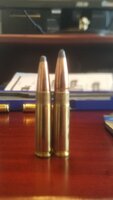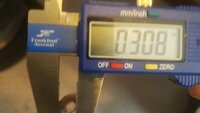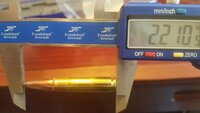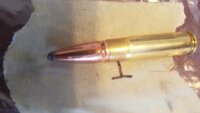This is one I haven't encountered before.
I'm loading 180 gr BTSP 300BLK cartridges. Hodgdon and other references say to set at 2.21" COL or very close to that (Speer says 2.18"). This puts the case edge well short of the cannelure, but I don't think that matters (which could be one of my misconceptions.)
I loaded up 4 each of 4 different charge loads, to see which one worked the best to load the rest of the inventory with. I started at 13.0 grains of Lil Gun, but that really doesn't matter as for what happened (or didn't) next.
I loaded the first set into some PMAG 300BLK mags (not 5.56), loaded the first round into the gun, and heard the dreaded 'click' when I expected a 'bang'. I tried to pull the charging handle back and it was jammed pretty good. With some persuasion, I did get the round out. This is what it looked like (it's the short one below.)

The rounds were the same length when I put it in the gun. After puzzling a bit, I loaded some more, same result. No bang, jammed round. Different mag, same result. I had brought some other rounds (also handloads) with me and loaded them to see if I was losing my mind or my gun. They worked perfectly.
WTH happened? The other rounds also compressed, but not like the first one. I measured the bullet to make sure it was in fact a .308 bullet, though I don't know why that would keep it from firing, and they were fine.

I measured the rest of the batch I hadn't chambered, or attempted to chamber, and they were in fact 2.21".

I noticed some marks on one of the rounds when I finally got it out of the chamber and it had a scratch in it, though I don't know if this was caused by the bolt coming forward or the somewhat violent extraction with the charging handle.

I've never seen this happen before. The other rounds that worked fine in the same gun/mag/etc... were at 2.23", slightly longer than the ones that didn't work.
What's going on? Any ideas? This is a new one for me.
thanks all!!!
MG
I'm loading 180 gr BTSP 300BLK cartridges. Hodgdon and other references say to set at 2.21" COL or very close to that (Speer says 2.18"). This puts the case edge well short of the cannelure, but I don't think that matters (which could be one of my misconceptions.)
I loaded up 4 each of 4 different charge loads, to see which one worked the best to load the rest of the inventory with. I started at 13.0 grains of Lil Gun, but that really doesn't matter as for what happened (or didn't) next.
I loaded the first set into some PMAG 300BLK mags (not 5.56), loaded the first round into the gun, and heard the dreaded 'click' when I expected a 'bang'. I tried to pull the charging handle back and it was jammed pretty good. With some persuasion, I did get the round out. This is what it looked like (it's the short one below.)

The rounds were the same length when I put it in the gun. After puzzling a bit, I loaded some more, same result. No bang, jammed round. Different mag, same result. I had brought some other rounds (also handloads) with me and loaded them to see if I was losing my mind or my gun. They worked perfectly.
WTH happened? The other rounds also compressed, but not like the first one. I measured the bullet to make sure it was in fact a .308 bullet, though I don't know why that would keep it from firing, and they were fine.

I measured the rest of the batch I hadn't chambered, or attempted to chamber, and they were in fact 2.21".

I noticed some marks on one of the rounds when I finally got it out of the chamber and it had a scratch in it, though I don't know if this was caused by the bolt coming forward or the somewhat violent extraction with the charging handle.

I've never seen this happen before. The other rounds that worked fine in the same gun/mag/etc... were at 2.23", slightly longer than the ones that didn't work.
What's going on? Any ideas? This is a new one for me.
thanks all!!!
MG

